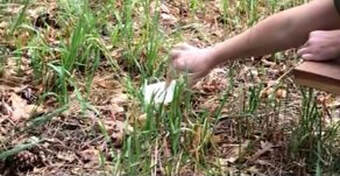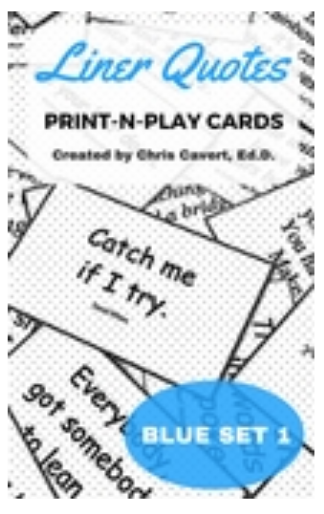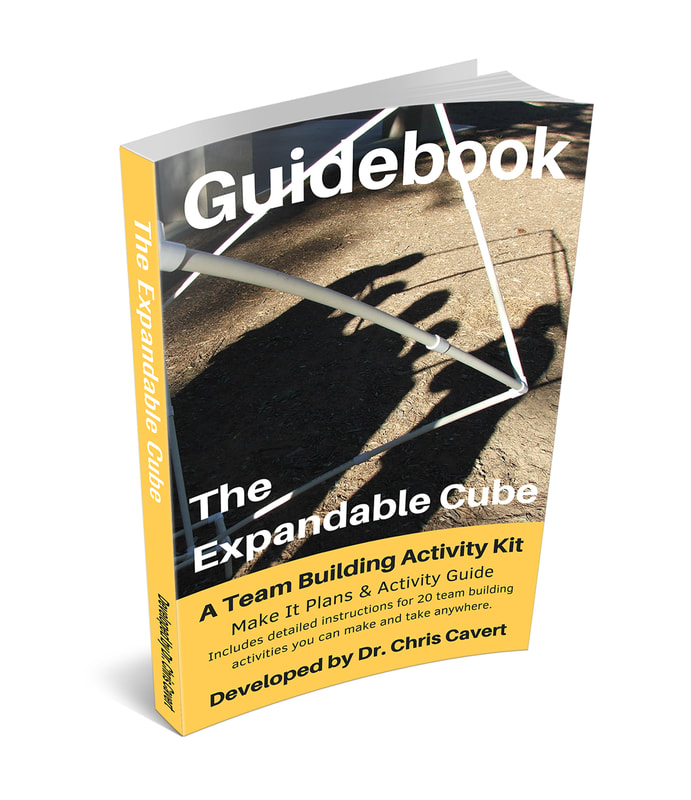There are three platforms six to eight feet apart. Two, five to six foot boards are provided. A group of 10 to 12 participants is challenged to get from the first platform to the third platform without the boards or anyone in the group touching the ground. (This is the nutshell idea. There are a few more details.)
As you can see in the image above, a single board will not span the distance from one platform to the other. However, two boards together in an overlapped configuration with participants standing on enough of one end of each board can support someone moving across. (NOTE: At least one foot must be in contact with a board or platform at all times - i.e., no jumping.)
At first, there is some good group problem solving going on. But once the board configuration is solved, it's all about moving people - there is very little problem solving left (other than managing participants on platforms). Despite the access I've had to this element I've rarely used it over the years due to engagement levels...until recently. Hence, A New Way Through the Mountain Tops.
Set Up: Check out the picture up in the header. The first and third platform are 4 x 4 feet and six inches high. The middle platform is 3 x 3 feet, six inches high. There is one six foot board (2 x 6 inches) on the center platform. The other two boards are 5 feet long (2 x 6 inches). The platforms are seven feet apart.
Now, look closely to see the small white squares near the platforms. Those are Jumbo Bananagram letter tiles placed with the letters down (see the pictures below for a close up with letters up). There's lots more about these tiles below. (NOTE: There are also a few wooden, light brown, stumps near the right platform left over from a Zig Zag - those are not used with this element.) Each tile is placed three to four feet away from the platforms. You can use any type of letter tile you can get your hands on. The most accessible might be small paper plates with letters on them. And, if you can write the letters on the plates so participants can't see the numbers through the bottom of the plates, that would be optimal. (We want to provide a little mystery at the onset.)
Setting Out Letters - In the Big Picture (I don't share this with participants), the group will be tasked to discover and/or form three words using all the letters. So, when I set down the letters I mix up the first word letters around platforms two and three (counting from left to right). I mix up the second word letters around platforms one and three. And, the third word letters around platforms one and two. (This may become clearer as you read through to the end of this description. If not, send me an email and we'll talk.)
Group: 9 to 12 participants is optimal (I've seen it done with up to 15 using the set up in the picture above.) I'd do this one with middle school ages on up.
Now, I don't tell the group about the words at this point. Before the first challenge I tell everyone: All of you need to be responsible for taking at least one word with you into the challenges. If needed, you can be responsible for two words, but no more than two. This process is essentially the first team building task they have to go through.
When the group tells me that everyone has her/his letter (or letters), I give them the first challenge. (NOTE: You can check in to make sure all the letters are assigned, or let the group move on without checking. Out the 15 attempts I observed recently, two groups went into the first challenge without all the letters being assigned. Good talking point here.) After all of my observations, I found that giving the group directions to the first challenge while everyone is still standing off to the side of the element provides space for some key planning they might consider. (For example, once they find out the first challenge, they strategically place people on platforms where they have the most success flipping over the tiles, And for some, being on a platform that has enough tiles to flip over - when someone has more than one tile to flip.)
(During this brief, there is some information relevant to all the challenges - the bullets.) The following is an example of a possible script:
- This activity involves three challenges.
- You'll need to complete the first to move on to the second. Then, you need to complete the second challenge in order to move onto the third.
- You will have 20 minutes to accomplish all three challenges. [NOTE: I found this to be a good time frame - they either accomplish all three tasks or they don't. Good talking points.]
- For all three challenges you will be allowed a total of 10 fouls - after the 10th foul you will start over with the first challenge.
- Fouls: 1) When a participant touches the ground - every three seconds touching the ground is a foul. The exception to a person touching the ground is when she/he is working with a tile. Slight ground touches are okay in this instance. 2) When a board touches the ground - every three seconds a board touches the ground is a foul. 3) When a board touches a tile. 4) When a tile is thrown or dropped to the ground after being picked up. 5) When a board is thrown - for obvious safety reasons. 6) When anyone is not in contact with a board or platform - essentially, no jumping.
The first challenge involves simply flipping over all the tiles you see on the ground near the platforms. Simply flip over and leave it where it was. You may not begin to touch the tiles until everyone in your group is standing on top of a platform. Once everyone is standing on a platform all fouls are live until all three challenges are complete or your 20-minute time frame is up.
SAFETY NOTE: Please be mindful and avoid pinching any fingers or toes with the boards during the activity.
You may only flip over the number of tiles equal to the number of letters you are responsible for - if you are responsible for one letter, you flip over only one tile. Two letters, flip over two tiles. Are there any questions about the rules or your first challenge? [Answer questions here.]
If there are no more questions, your 20-minute time frame starts NOW!
I'm also thinking that if there are some taller people in the group, move some tiles out away from the platforms even further. Will the group assess this ahead of time. If the distribution of the people does not line up with the tiles, challenge 1 will take longer to accomplish. (The 'prior planning prevents poor performance' discussion.)
The big Mountain Top change for me with Challenge 1 is that now everyone is actively engaged in either flipping a tile or helping the flipper. They also pick up the 'diving board' use of the boards which will lead to moving from platform to platform.
One final point. If there are participants responsible for more than one letter, and the group did not plan for this, some of them may need to move to a different platform to flip over another tile - hence, preparing them for Challenge 2. (If you don't want this to happen, create three words with the total number of letters equal to the number of people in the group.)
SAFETY NOTE: When people are moving across boards to different platforms, be sure to spot the crossing - it's very common for boards to slip or move down towards the ground. And, boards can break. So, you might choose to have groups reassess board placement before someone crosses - for safety reasons.
You can lead this processing time out while they are all standing on the platforms or bring them down off the platforms to another space. If you bring them down, let them know they must all return to the same platform before beginning challenge 2.
After the processing time out, ask everyone to step back up onto the platform they ended with after challenge 1. Then give them challenge 2.
Your next challenge will be to retrieve the letter or letters you are responsible for - the letters you chose at the beginning of the activity. You may only touch a letter tile(s) you are responsible for. Meaning, you can't pick up someone else's letter and hand it to her/him. Do you have any questions? [Answer here.]
If there are no more questions, you have _____________ (time) remaining on your 20-minute timeframe. Time restarts now.
That's it. They are off to work on moving people from platform to platform. Now, some people might be on the platform they need to be on - less work for them. Others will need to travel.
As you can see in the picture above, it is perfectly okay to have a gap between the boards. Just be sure to spot anyone crossing. Also, if you are the only facilitator with the group, require that only one person may cross at a time so you are able to spot them. In most cases there are things/tasks to accomplish at each platform, so there is little waiting around if they are on top of 'things.'
For this challenge there are some options. If the group is within 5-minutes of working time, give them the 'get-to-it' version:
For your final challenge, your letters make up a sentence - Team Work Rules. Well of course it does!! You are required to bring your letter(s) to the appropriate platform. TEAM will be at the first platform. WORK at the SECOND and Rules at the third. Again, you may not hand off or pass your letter(s) to someone else - you must take them to where they belong. Once you get to the appropriate platform you are allowed to place your letter on the ground in front of your platform in order to spell out the word your letter is part of. No foul will be given.
If there is more than 5-minutes left on the clock, give them another problem to solve:
This final challenge has two parts. The first part is to use all the letters within your group to create a sentence. Here's a hint. The sentence is made up of two words. However, within the two words, there are three words. And yes, you need to stay on the platforms while you work on solving the problem.
Now, you may need to give some hints along the way so it doesn't take too much of their time remaining - keep an eye on the clock. Once they have figured out the sentence, give then the second part of the challenge:
You are required to bring your letter(s) to the appropriate platform. TEAM will be at the first platform. WORK at the second and RULES at the third. Again, you may not hand off or pass your letter(s) to someone else - you must take them to where they belong. Once you get to the appropriate platform you are allowed to place your letter on the ground in front of your platform in order to spell out the word your letter is part of.
Once they have completed the third challenge, bring them down off the platforms for some processing.
As you might have already figured out, if the group commits 10 fouls you can bring them down off the platforms and have them take a little mental (and possibly physical) break while you reset the activity. This is, of course, if you have the time for them to restart. You have the option to give them only the remaining time on the initial 20-minute time frame or give them a new 20 minutes. This will depend upon the overall time allowed for your program and the outcomes you are working on.
Processing:
There are lots of things to talk about for this one. Here are some things I've seen:
- Describe your planning process for the first challenge. What went well right away? If so, how did your plans change during the challenge? If anything, what did you overlook during your initial planning time?
- Describe any changes that took place in regards to planning for the second and third challenges. What influenced your planning for these challenges?
- What do you remember about your communication between platforms throughout the challenges? What communication behaviors worked well? What communication behaviors didn't work so well?
- What were your resources during the challenges? How did you utilize your resources? In what ways could your resources have been better utilized?
- If you made mistakes (fouls) during the challenges, how did you go about fixing them? Did the same mistakes happen more than once? If so, why do you think this happened?
- How was the workload distributed during the challenges - Evenly? How did you divide up the work? Unevenly? Why do you think this happened?
- What did you learn from the challenges that you want to remember after this program?
All the best,
Chris Cavert, Ed.D.















 RSS Feed
RSS Feed